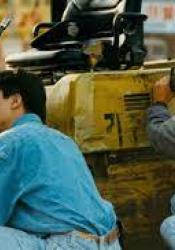The LA Riots of 1992
April 29, 1992: The jury acquits all four officers of assault and three of them of excessive force. This acquittal sparks what is known as the LA riots of 1992, and is also the date the riots officially begin (Bates, Sastry). Korean-Americans refer to this day as Sa-I-Gu (사이구), which means “4/29” in Korean, the day when the riots began.
April 30, 1992: Defense lines are set up that keep wealthy white neighborhoods on the inside with Koreatown to effectively act as a shield. Additionally, the LAPD never arrived when Koreans cried for help, so they were forced to take matters into their own hands. As Korean men are all required to serve in the military, many took to arms themselves and defended their stores with guns. This image was televised and broadcasted everywhere, even still being relevant today in discussions of arms and the second amendment in the USA (being oft referred to as “Roof Koreans). Koreatown suffered $400 million worth of damages, over half of what was sustained throughout the entire LA riot (Wong).
This fear was even recognized outside of California, as even my father (who is also Korean-born) was called to defend his family’s shop in inner-city Chicago. “It was very scary, but also kind of silly” he said in retrospect, “I’m there with my cousins and uncles who are military trained and armed to the teeth. And I’m standing there, just a teenager holding my skateboard like a club, in case anyone slips past” (Park). Jokes aside, Korean-Americans across the country still understood the fear and the pressure brought on by the riots and all responded in similar ways.
May 1, 1992: Rodney King publicly pleads for everyone to “all get along,” and over 10,000 Army National Guard troops were activated in order to stop the rioting. The mayor also enacts a curfew in order to achieve the same effect. At this point the majority of the violence in the riots have come to a stop, and will officially be over within a few days (May 5th). However, the aftermath of this is still remembered to this day (Bates, Sastry).
Sources:
Bates, Karen Grisby and Sastry, Anjuli. “When LA Erupted In Anger: A Look Back At The Rodney King Riots.” NPR, 26 April 2017. https://www.npr.org/2017/04/26/524744989/when-la-erupted-in-anger-a-look-back-at-the-rodney-king-riots. Accessed 3 November 2021.
Lah, Kyung. “The LA riots were a rude awakening for Korean-Americans.” CNN, 29 April 2017. https://www.cnn.com/2017/04/28/us/la-riots-korean-americans/index.html. Accessed 3 November 2021.
Park, Gilbert (my father). 2015.
Wong, Brittany. “The Real, Tragic Story Behind That ‘Roof Korean’ Meme You May Have Seen.” The Huffington Post, 11/6/2020. https://www.huffpost.com/entry/roof-koreans-meme-know-real-story_n_5ee110a1c5b6d5bafa5604f3. Accessed 4 November 2021.

